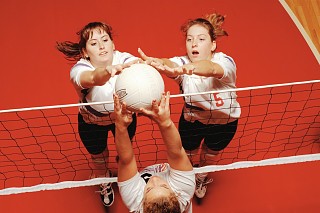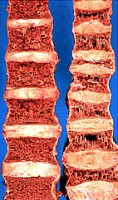 |
 |
Osteoporosis is a disease in which calcium is lost from the bones. It is most common in post-menopausal women, with about 80% of cases being amongst women over 50 years old. Literally, osteoporosis means "porous bone". It is a disease characterized by deteriorating bone density. It results in weaker bones and an increased chance of fractures of the hip, spine, and wrist. While much more common among women – one half of all North American women will have a fracture after 50 years of age – it also affects about one eighth of men as well.
 |
The spine on the left is that of a middle aged man. It shows a small amount of bone degeneration. The right hand spine is that of an elderly woman, and the extremely porous bone is very obvious. |
By about age 20, the average woman has acquired 98% of her bone mass. Building strong bones during childhood and adolescence is probably the best defense against developing osteoporosis later. Building strong bones requires:
 Exercise, particularly exercise which
involves running and jumping, has been shown to cause major increases in bone
density. Weight-supported exercise (swimming or cycling for example) is less
effective. Bone is alive. It is made mostly of collagen, a protein that
provides a soft framework, and calcium phosphate, a mineral that adds strength and hardens
the framework. This combination of collagen and calcium makes bone strong yet
flexible to withstand stress. Since bone is alive, it responds to stress by becoming
even stronger.
Exercise, particularly exercise which
involves running and jumping, has been shown to cause major increases in bone
density. Weight-supported exercise (swimming or cycling for example) is less
effective. Bone is alive. It is made mostly of collagen, a protein that
provides a soft framework, and calcium phosphate, a mineral that adds strength and hardens
the framework. This combination of collagen and calcium makes bone strong yet
flexible to withstand stress. Since bone is alive, it responds to stress by becoming
even stronger.
We all know that our muscles become more fit because of exercise. The fact that bone also gets stronger is not nearly as well known. This is especially true during adolescence when bone is growing most rapidly. Unfortunately, it is also at this point in their life that most North American women stop exercising, and start smoking. Though they may begin to exercise later on, the most important period for developing strong bones will be lost if exercise does not continue through the teenage years.
The University of Saskatchewan's College of Kinesiology is one of the leaders in research into the effects of exercise on bone growth.
References:
Donald A Bailey, P. E. D., Robert A. Faulkner, Ph. D., Heather A.
McKay, Ph. D., "Growth, Physical Activity and Bone Mineral Acquisition", Exercise
and Sport Sciences Reviews, (24) 1996.